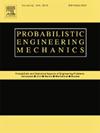A novel self-adaptive step size first-order method for structural reliability analysis based on modified Sigmoid function and Armijo rule
IF 3.5
3区 工程技术
Q2 ENGINEERING, MECHANICAL
引用次数: 0
Abstract
Among the first-order reliability methods (FORM), the Hasofer-Lind and Rackwitz-Fiessler method (HL-RF), and the chaos control method (CC) rely on a fixed step size and cannot generate an adaptive one, making it difficult to achieve a satisfactory trade-off between efficiency and robustness when dealing with highly nonlinear problems. To address these drawbacks, this paper proposes two innovative first-order reliability methods: the Sigmoid-based self-adaptive step size adjustment method (SSA) and the hybrid Sigmoid-based self-adaptive step size adjustment method (HSSA). The iterative rotation angle is first determined for both proposed methods. In the SSA method, a modified Sigmoid function is employed to enable nonlinear adaptive adjustments of the step size based on changes in the iterative turning angles, allowing for rapid convergence. Subsequently, the HSSA method incorporates the Armijo rule to further explore a more effective solution. Both proposed methods demonstrate strong computational merits, favorable performance, and user-friendly procedures, providing self-adaptive step sizes suitable for engineering problems, thus offering a broad range of applications. The paper introduces eight examples to showcase the remarkable performance of the two proposed methods. The results indicate that both methods exhibit significantly superior efficiency and robustness compared to other comparative analytical FORM methods when addressing highly nonlinear engineering challenges. Finally, a discussion is presented.
基于修正Sigmoid函数和Armijo规则的一阶结构可靠度分析方法
在一阶可靠性方法(FORM)中,hasfer - lind和Rackwitz-Fiessler方法(HL-RF)和混沌控制方法(CC)依赖于固定的步长,不能产生自适应的步长,这使得在处理高度非线性问题时难以在效率和鲁棒性之间实现满意的权衡。针对这些不足,本文提出了两种创新的一阶可靠性方法:基于sigmoid的自适应步长调整方法(SSA)和基于混合sigmoid的自适应步长调整方法(HSSA)。首先确定了两种方法的迭代旋转角度。在SSA方法中,采用改进的Sigmoid函数,根据迭代转角的变化对步长进行非线性自适应调整,实现了快速收敛。随后,将HSSA方法纳入Armijo规则,进一步探索更有效的解决方案。所提出的两种方法都具有很强的计算优点,良好的性能和用户友好的程序,提供适合工程问题的自适应步长,从而提供了广泛的应用。本文通过8个实例来展示这两种方法的显著性能。结果表明,在处理高度非线性的工程挑战时,与其他比较分析FORM方法相比,这两种方法都具有显著的效率和鲁棒性。最后,进行了讨论。
本文章由计算机程序翻译,如有差异,请以英文原文为准。
求助全文
约1分钟内获得全文
求助全文
来源期刊

Probabilistic Engineering Mechanics
工程技术-工程:机械
CiteScore
3.80
自引率
15.40%
发文量
98
审稿时长
13.5 months
期刊介绍:
This journal provides a forum for scholarly work dealing primarily with probabilistic and statistical approaches to contemporary solid/structural and fluid mechanics problems encountered in diverse technical disciplines such as aerospace, civil, marine, mechanical, and nuclear engineering. The journal aims to maintain a healthy balance between general solution techniques and problem-specific results, encouraging a fruitful exchange of ideas among disparate engineering specialities.
 求助内容:
求助内容: 应助结果提醒方式:
应助结果提醒方式:


